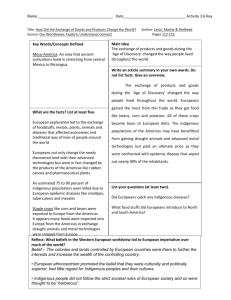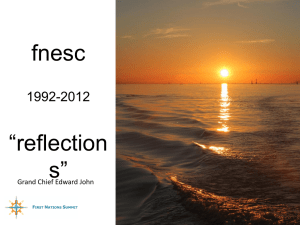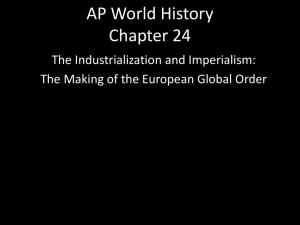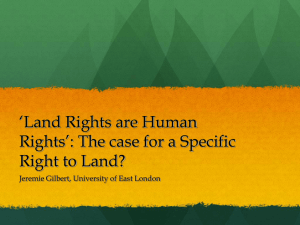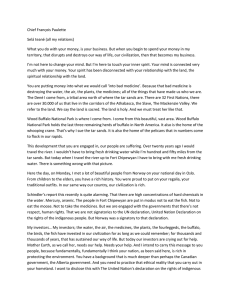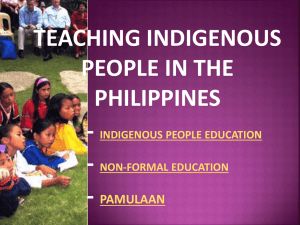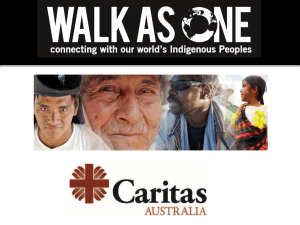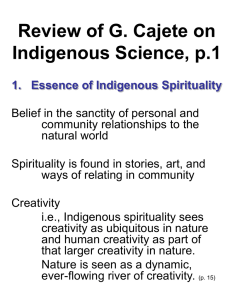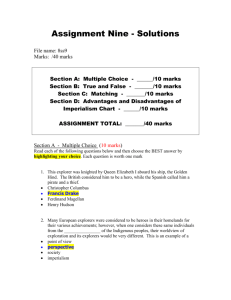Unit 2 Review
advertisement
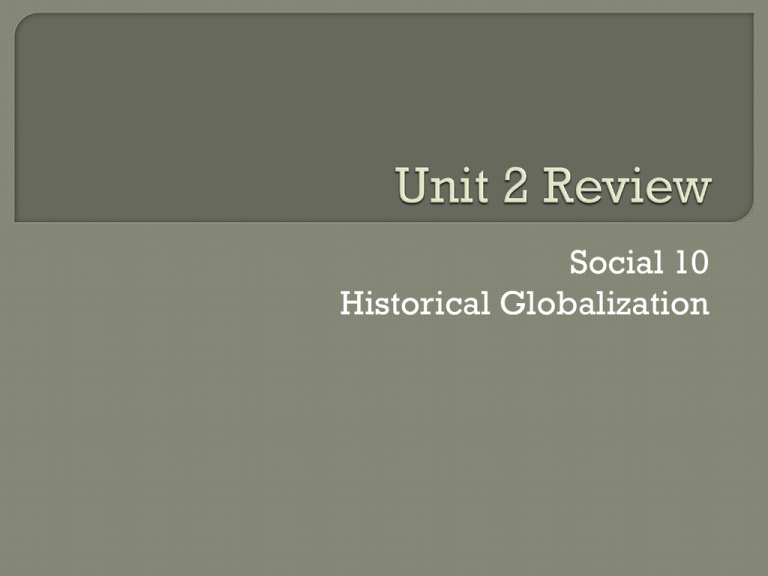
Social 10 Historical Globalization The Evolution of Globalization – Three Phases • Phase #1: Goods/ideas exchanged along trade routes (Silk Road). Arab civilizations were the first to transfer Indian knowledge of medicine, science, & mathematics to Europe. Phase #2: Began in the late 1400’s. Influenced by phase #1, Europeans developed technologies, allowing them to sail much farther around the world. Related to European imperialism: One country dominates another’s economic, political, and cultural organizations. Phase #3: Present Day Evolved from the second phase and started after WWII. This is a time of rapid growth Ex. World markets, Instant communications (internet, cell-phones, e-mail, etc.) Increasing rise of China/India as economic powers. 1. Creation of Printing Press 2. Rise of European Middle Class 3. Growth of New Ideas & Technologies 4. Global Competition for Trade 5. Rise of Imperialism 6. European Colonial Settlement Impact on Indigenous People and Europeans. 1. Disease 2. Enslavement 3. Grand Exchange 4. Industrialization Estimated Indigenous populations in 1492 and 1992 The Grand Exchange changed how the world ate. This may seem like a small thing but this is a symbol of what historical globalization was all about. Expanding trade from local markets to global markets. European diseases destroy large segments of indigenous populations. Slavery forcefully takes millions of innocent people out of Africa and ships them to the Americas. The Grand Exchange develops as the first large scale global trade network. The industrial revolution spurs more development and more need for resources and trade. “Ethnic” + “Centre” A way of thinking that focuses on your own race and culture. People believe the ‘best’ worldview is their own; judge other people by their beliefs, customs, and traditions. Early 1900’s; 50% of Canadians were from British decent. Many looked down upon Ukrainian & Chinese immigrants. 1884; Africa was divided up by the major European powers. Goal was to avoid conflicts, protect trade routes, and gain resources such as gold, diamonds, and rubber. However, Indigenous people were left out; lands and resources were taken from them. As Europe became increasingly wealthy and advanced life expectancy increased. • Dramatic rise in population • Population of Europe more than doubled from 188 million in 1800 to 432 million in 1900. • More people means less land and less opportunity (land hunger). • During the 19th century Europeans shift away from mere military and economic domination of territory towards outright settlement of those territories at the expense of indigenous populations. European migration naturally leads to the displacement of indigenous peoples. Indigenous peoples were: • forced off their land • colonizers needed land for settlement, railways, mining, and plantations (Sugar). Traditional forms of government and community boundaries were also ignored by the imperialists. New borders were drawn, social structures were destroyed. FAMINE and DISEASE played a part in depopulating India. • 1876-1879; 6-10 million Indians died of starvation alone. • 1896-1902; 19 million died of starvation and disease. These famines were largely created by British deindustrialization of India (destroying local Indian economy to improve British commercial activities). There were 60 million European migrants between 1815 and 1932. From the European perspective depopulations was a good thing. From an indigenous perspective this is not the case. • Forced migrations (slave trade, indentured labour, etc.) • Disease (Indigenous populations of the Americas) • Direct massacre (King Leopold in the Congo) The company controlled trade within India, and company officials became more powerful as a result. The company created a private Army to defend their interests. Supported the company’s Indian allies, but also kept out rivals. • Ex. Dutch East India Company Officers in the army were labeled as heroes back in Britain and as cruel taskmasters in India. Did imperialism have benefits for indigenous people? • Many argue that the exchange of goods and technology improved the lives of the indigenous people over time. Modern medicine and education Modern transportation (ships, trains, roads, canals, etc) Modern communication (newspapers, telegraph, etc.) Modern architechture Access to world markets • Do you see any merit in this argument? Imperialism also changed the cultures of the people under European control. • Religious beliefs; Christianity was spread to the countries under European rule. • Art; Any art exported to Europe had to reflect European taste and preferences. • Architecture; The British built massive buildings throughout India such as this railway station in Mumbai on the next slide. Early contacts between Europeans and Aboriginals were usually friendly, and beneficial. Aboriginals were excited to obtain goods such as axes, cooking pots. Europeans were eager to trade for food and animal pelts, most notably Beaver pelts. Europeans • Social status was based on land ownership and wealth. • Land ownership was a symbol of security, social status, and how much money you had. First Peoples • Status defined by ability, people shared the land to hunt, trap, etc. • Saw themselves as spiritual guardians of the land and stewards. The Seven Years War and British defeat of French in the Americas European Immigration and the displacement of aboriginal peoples Depopulation of Indigenous peoples Assimilation of the Indigenous peoples The proclamation limited settlement in Eastern North America. This land was reserved for the First Nations people. This was done by the British to maintain peace with the First Nations. They had previously been driven out of coastal areas, and pushed further inland. The Numbered Treaties • Eleven treaties were signed with aboriginal groups between 1871 and 1921. They were designed to gain access of land controlled by aboriginals. • The government essentially offered cash for land. In exchange for moving to reserves aboriginals were given annual cash payments and other benefits. This system remains to this day. • This system essentially kept the aboriginal community isolated from the rest of society. The Indian Act • First passed by parliament in 1876. • It meant that the First Nations people were under the complete control of government officials. • It defined who was and was not a status Indian. • It restricted movement and settlement, political rights, and employment. • It also opened the door to the residential school system. Early 1900’s; Immigration to Canada did not benefit everyone. Immigration policy was based on RACE. Those not from Europe/U.S. were discriminated against. By 1968, Canada’s immigration policy began to change. More people came from Asia, Caribbean, and Africa. Quebecois became aware that Francophones were being discriminated against. The Quiet Revolution gave a voice for those wishing for a renewal of Francophone language and culture. Some believed the only way to gain renewal was to separate Quebec from Canada. Ex. Parti Quebecois Rwanda is largely made up of two Indigenous groups: The Hutus and the Tutsis. Before the scramble for Africa in the 1880’s: • Hutus: 85% of the population • Tutsis: 15% of the population Tutsis were given more power than the Hutus by Belgian colonial powers. • Tutsis were more ‘European’, that is they were taller and lighter skinned. • This is an example of a divide and conquer policy. South Africa has a history of racism. The 20% white minority has historically controlled and exploited the 80% black majority. This is a clear legacy of the era of imperialism. In 1991 South Africa ended the Apartheid regime, ending years of state-sanctioned racism. In 1994 they elected their first black president, Nelson Mandela. In 1995, President Mandela created the Truth and Reconciliation Commission. It confronted the country’s past, unite the victims/those accused of crimes. The increase in speed, range, and the depth of global trade has had a huge impact. Global Income Equality • growing gap between the rich and the poor. • NGOs help this issue by providing aid, loaning money, and distributing food. What is ‘Foreign Aid’? Money, advice, material supplies, and other goods given by one country to help another. In most cases, developed countries provide for undeveloped countries. MAJOR GOAL=REDUCE POVERTY! Also, the aim is to promote a secure, and prosperous world. STUDY.... Look through your notes, formative booklets, take a text book home, quiz each other, review the vocabulary, Social is Conceptual... Know the concepts and major ideas Know examples of the major ideas
